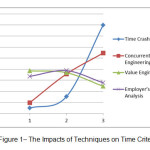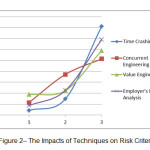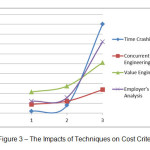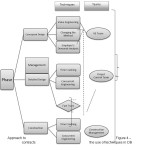Providing A Model for Reducing the Time of Construction Phases
Arman Moslemi1 * and Eghbal Shakeri2
1
Department of Civil Engineering and Environmental,
Amirkabir University of Technology,
Tehran,
Iran
2
Department of Civil Engineering and Environmental,
Amirkabir University of Technology,
Tehran,
Iran
DOI: http://dx.doi.org/10.12944/CWE.10.Special-Issue1.31
In construction projects, each type of delay in implementation and lack of exploitation of them is the precise instance of wasting the resources. The most important resource which is wasted in this regard is the element of time which is the most valuable capital of nations in today’s fast-paced world. Sometimes, the profit resulting from early completion of the project may tempt the employers and project owners to reduce the time of project. Some other times, macro policies may urge a project to be exploited earlier than its due date. After introducing the time reduction techniques briefly in this paper, the challenges of these techniques were specified through interviewing with the experts. Then three criteria were selected to investigate the techniques. Using the results of the questionnaire, the impact of these techniques on the criteria was then dealt with in different phases of the project in Design and Build contracts.
Copy the following to cite this article:
Moslemi A, Shakeri E. Providing A Model for Reducing the Time of Construction Phases. Special Issue of Curr World Environ 2015;10(Special Issue May 2015). DOI:http://dx.doi.org/10.12944/CWE.10.Special-Issue1.31
Copy the following to cite this URL:
Moslemi A, Shakeri E. Providing A Model for Reducing the Time of Construction Phases. Special Issue of Curr World Environ 2015;10(Special Issue May 2015). Available from: http://www.cwejournal.org/?p=9790
Download article (pdf)
Citation Manager
Publish History
Select type of program for download
| Endnote EndNote format (Mac & Win) | |
| Reference Manager Ris format (Win only) | |
| Procite Ris format (Win only) | |
| Medlars Format | |
| RefWorks Format RefWorks format (Mac & Win) | |
| BibTex Format BibTex format (Mac & Win) |
Article Publishing History
| Received: | 2014-11-25 |
|---|---|
| Accepted: | 2014-12-12 |
Introduction
The need for reducing the time of project is observed in the majority of construction projects. This need is caused by the following factors2
Acceleration
The need for acceleration is one of the reasons that time reduction techniques are used in projects. The reasons of acceleration can sometimes be economic. It means that the profits made by exploiting the project may be more than the expenses required for acceleration; therefore, it would be required to accelerate the project. However, other reasons may pertain to politics, military and national interests.
Delay Compensation
Each project may have delays in implementation. Time reduction techniques are used to compensate these techniques and to be back on the original schedule of the project.
Since reducing the time is an essential matter for construction projects, extensive investigations have been conducted on this field in order to create different time reduction techniques. Each of these techniques influences other aspects of the projects such as expenses, as well as the time. Therefore, these aspects should be considered while using such techniques.1
Using the previous researches, studying the available sources and interviewing with the experts, four techniques were investigated as the main techniques for reducing the times of projects in this paper. Before introducing the techniques, it should be pointed out that correct project management is considered as a precondition of applying time reduction techniques. Each project requires accuracy and correctness in work; therefore, it is totally essential to follow some principles so that delay would be prevented in each project. Some references stated these principles as time reduction techniques, whereas such techniques should be used in cases in which the project implementation is based on principles. For instance, a project which mismanaged would obviously have some delays resulting from malfunctioning of management. If the management is changed, the project will be naturally progressed well and timing will be improved. However, time reduction cannot be considered as a technique because following the correct management is among the necessary conditions in a project.
The techniques investigated in this paper are as follows
The Techniques which Influence the Critical Path
Time crashing Technique
A common method for reducing the time of projects is to increase the resources which compress and reduce the tasks. Reducing the time through increasing the resources is named crashing.1 Increasing the resources would have lesser complexities and more certainty in comparison with other methods. Although it may increase the expenses considerably, it has lesser risks which are known. It is one of the most common methods which are used to decrease the time. The resource-increasing technique is actually the same as time-cost trade off.2,3
Concurrent Engineering Technique
Concurrency means that two or more events happen at the same time, a synonym of parallelism. It is a term which is used in performing the tasks or stages of a project in planning and controlling a project.2 Two tasks are concurrent when all or some of them occur at the same time. Moreover, the parts of the two tasks which are performed simultaneously are called overlapped. Different levels of projects can be done concurrently. This concurrency can be done among the tasks of a project and also among the working packages and stages of a project.1,3
The Techniques which Influence the Nature of Tasks
Value Engineering
Value engineering technique would try to reduce the time and maintain the quality of project through innovation and new ideas. Normally, this technique is exercised at the beginning of the project by the value engineering team which investigates different solutions and hold meetings for brainstorming.1
Employer’s Demands Analysis
Employer’s Demands Analysis should be done on the nature of tasks and problems influencing the objective of analysis (reducing the project time). If employer’s demands and requirements which are the design principles of project change or decrease properly, the time and cost of project will decrease. The sooner the demands change occur in the project, the higher efficiency and the lower cost it will bring.1 The greatest impact on time-reduction of the project occurs when unnecessary functionalities can be deleted from the project in the stages of conceptual and basic design.1
The Impacts of Techniques in Different Phases of Project
Conducting studies, investigations, and interviews with the experts, several challenges were obtained for time reduction techniques (Table 1). Investigating these challenges and interviewing with the experts in this field, some of the challenges were then combined with each other, and some were deleted due to similarity or unimportance. Finally, three main criteria were selected out of the challenges. They were time reduction, risk increase and cost rise, respectively. After extracting the criteria through interviewing and filling out the tables, the comments of the experts were questioned on the impact of techniques on the criteria in different phases of the project. The statistical population included 28 individuals of university teachers and also the industry experts working on the subject of time reduction techniques.
Table1: Risk of techniques
| Increased direct costs not included |
| Failure to reduce indirect costs |
| Loss of efficiency and productivity |
| Work interference |
| Increased risk of people’s life |
| Degradation |
| Lack of resources |
| Time increased |
| Rework |
| No optimization |
| Non-cooperation |
| Disputes and claims |
| Failure to accept changes |
| Failure to achieve project goals. |
| No team for Value Engineering |
Given the results of the questionnaire, the impact of techniques on the criteria in different phases of the project is shown in Table 2 and Figures 1-3.It should be noted that the x axis of the charts indicates the phase of conceptual design in Number 1, the phase of detailed design in Number 2, and construction phase in Number 3.
According to the results obtained in the subject of the impact on time reduction, two techniques of increasing the resources and concurrent engineering had the greatest impact on the construction phase, whereas two techniques of value engineering and employer’s demands analysis had the greatest impact on the phases of conceptual and detailed design. This difference can be sought in the classification of these techniques. The first two techniques had the greatest impact on the critical path; therefore, they influenced the construction phase. Two other techniques influenced the nature of tasks which had impacts on the phase of conceptual construction.
Given the results obtained in the subject of the impact on risk and cost increase, the more the project progresses, the more these two criteria increase in all techniques. It means that the more the project advances toward completion, the more the risk and cost of creating the changes increase. However, it should be noted that the risk and cost of increasing the resources and concurrent engineering should be inevitably borne in order to reduce the time more. Not only do the risk and cost increase for the techniques of value engineering and employer’s demand analysis as the project progresses, but also the potential of time reduction decreases.
Table2: The Impacts of Techniques in Different Phases of Project
| Concurrent Engineering | Time Crashing | Value Engineering | Employer’s Demands Analysis | ||
| Time Reduction | conceptual design | 9.73 | 4.83 | 38.53 | 33.54 |
| detailed design | 35.67 | 15.23 | 36.89 | 38.74 | |
| construction | 54.6 | 79.94 | 24.58 | 27.72 | |
| Risk Increase | conceptual design | 11.45 | 4.27 | 18.76 | 8.65 |
| detailed design | 37.18 | 14.74 | 22.34 | 22.37 | |
| construction | 51.37 | 80.99 | 58.9 | 68.98 | |
| Cost Rise | conceptual design | 8.96 | 2.02 | 21.46 | 12.07 |
| detailed design | 12.18 | 3.96 | 27.38 | 15.82 | |
| construction | 23.75 | 94.02 | 51.16 | 72.11 | |
 |
Fig. 1: The Impacts of Techniques on Time Criteria Click here to View figure |
 |
Fig. 2: The Impacts of Techniques on Risk Criteria Click here to View figure |
 |
Fig. 3: The Impacts of Techniques on Cost Criteria Click here to View figure |
Results and Conclusion
According to the points mentioned in this paper and considering the contract of Design and Build as a method of proper implementation to apply the time-reduction techniques, the optimal way of using the techniques in different phases is as follows
Conceptual Design Phase
In this phase, it would be better to use value engineering technique. Therefore, the value engineering team comes into action to design and advance the project through creativity and new ideas so that it helps the strategies of achieving the project objectives.
However, the value engineering team can apply employer’s demand analysis, too. Analyzing the employer’s demands and having different meetings with the employer, it can change or delete some demands which are contradictory to the objectives of the project so that an optimal and definite framework is defined.
Detailed Design Phase
In this phase, the value engineering team continues to keep up with the project to update the information and apply predetermined changes.
Time crashing technique can come into action in this phase. Therefore, it reduces the project time through increasing the resources in three ways (increasing the hours of one shift, increasing the number of shifts, and increasing the forces). Concurrent engineering technique can also have good impacts on time reduction in this phase. Using this technique according to the type of dependencies, it is tried to make the tasks concurrent.
The Fast Track technique which is a subcategory of concurrent engineering technique should also start from this phase so that the design phase and construction phase overlap with each other through overlapping the tasks.
For instance, instead of the case in which one individual performs all the tasks to design a steel structure, one individual is responsible for modeling the structure, another one is responsible for designing the foundation, someone is responsible for designing the connections, and two individuals are responsible for drawing the maps. Here, two techniques of time crashing and concurrent engineering are used. It means that two planners are used instead of one so that the planning time decreases through the time crashing technique. Moreover, concurrent engineering is used through dividing one task into several tasks and overlapping them. Now if it is asked to use the fast track, too, the data can be given to the designer of the foundation so that it is done faster through initial modeling and before the complete design of the structure and connections is performed. Therefore, the implementation team can execute the foundation at the same time as designing the structure. Here, the role of management is of high importance. The management should have the necessary control over the objectives and procedure of the project to meet the following needs:
- Strong Relationships between the Factors
- Speeding up the Data Transfer
- Strong Management of Changes and Rapid Creation of Reworkings
- Risk Taking
- Management of Conflicts Caused by the Risks and Delays
Implementation Phase
In this phase, the value engineering team continues to keep up with the project to announce and monitor the predetermined changes. However, the responsibility of construction management team becomes sensitive in this case because the construction stage has more importance than the rewordings and interventions. Generally, the risks have more impact on time and cost increase.
In this phase, two techniques of concurrent engineering and time crashing can have proper impacts on the time reduction of the project. Accordingly, the activities on the critical path are investigated. Given the two criteria of cost and risk, the most optimal technique is selected. This optimal selection may be a combination of the two techniques of concurrent engineering and time crashing. The explanations which are indicated as a model are presented in Figure 4.
 |
Fig. 4: Approach to the use of techniques in DB contracts Click here to View figure |
References
- A guide to the project management body of knowledge: PMBOK guide (Project Management Institute Inc. Third Edition, 2004).
- An Investigation of Schedule Reduction Techniques (Construction Industry Institute, The University of Texas at Austin, 1996).
- Concepts and Methods of Schedule Compression (Construction Industry Institute, The University of Texas at Austin, 1998).






